Abstract
THERMAL recombination of positive holes and trapped electrons in irradiated solids may be regulated by two rather distinct mechanisms. The first possibility is that the electron is activated out of its trap into the conduction band, and thereby becomes “free” with an extended range before undergoing recombination or retrapping. A model of this type with a suitable distribution of trap depths was first suggested for ionic solids1, and it has since been applied to explain the radiation-induced conductivity of hydrocarbon polymers2. A second mechanism of recombination involves the diffusive motion of the trapped electron3, and this communication shows that this model predicts the absolute rate of recombination in simple hydrocarbon glasses.
This is a preview of subscription content, access via your institution
Access options
Subscribe to this journal
Receive 51 print issues and online access
$199.00 per year
only $3.90 per issue
Buy this article
- Purchase on Springer Link
- Instant access to full article PDF
Prices may be subject to local taxes which are calculated during checkout
Similar content being viewed by others
References
Randall, J. T., and Wilkins, M. H. F., Proc. Roy. Soc., A, 184, 366 (1945).
Fowler, J. F., Proc. Roy. Soc., A, 236, 464 (1956).
Debye, P., and Edwards, J. O., J. Chem. Phys., 20, 236 (1952).
Onsager, L., Phys. Rev., 54, 554 (1938).
Freeman, G. R., and Fayadh, J. H., J. Chem. Phys., 43, 86 (1965).
Williams, F., J. Amer. Chem. Soc., 86, 3954 (1964).
Buchanan, J. W., and Williams, F., J. Chem. Phys., 44 (1966).
Bueche, F., J. Chem. Phys., 30, 748 (1959).
Funabashi, K., Herley, P. J., and Burton, M., J. Chem. Phys., 43, 3939 (1965).
Williams, M. L., Landel, R. F., and Ferry, J. D., J. Amer. Chem. Soc., 77, 3701 (1955).
Keene, J. P., Land, E. J., and Swallow, A. J., J. Amer. Chem. Soc., 87, 5284 (1965).
Author information
Authors and Affiliations
Rights and permissions
About this article
Cite this article
WILLIAMS, F., HAYASHI, K. Charge Recombination in the Radiolysis of Liquid and Glassy Hydrocarbons. Nature 212, 281–282 (1966). https://doi.org/10.1038/212281a0
Issue Date:
DOI: https://doi.org/10.1038/212281a0
Comments
By submitting a comment you agree to abide by our Terms and Community Guidelines. If you find something abusive or that does not comply with our terms or guidelines please flag it as inappropriate.



